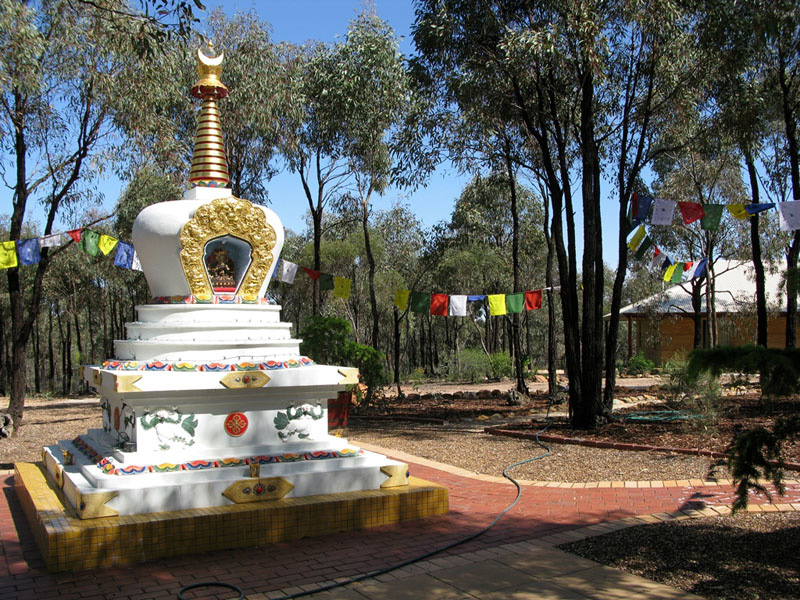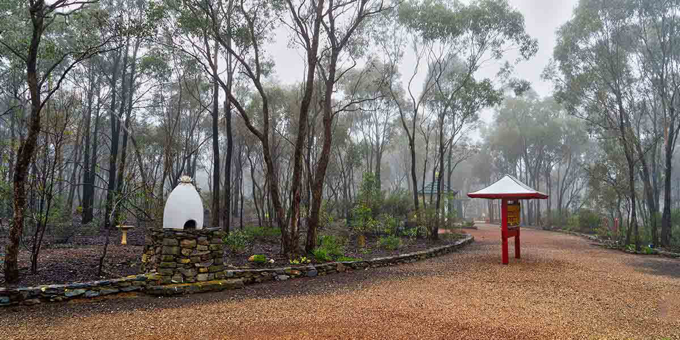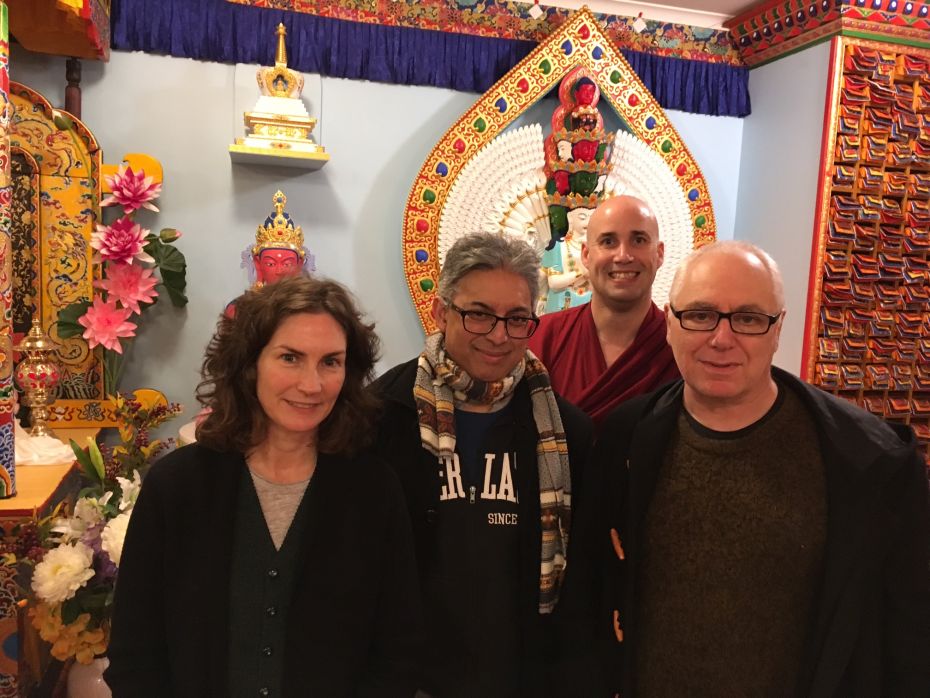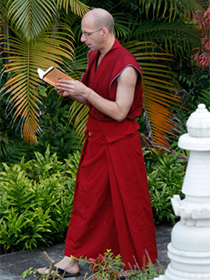- Home
- FPMT Homepage
Foundation for the Preservation of the Mahayana Tradition
The FPMT is an organization devoted to preserving and spreading Mahayana Buddhism worldwide by creating opportunities to listen, reflect, meditate, practice and actualize the unmistaken teachings of the Buddha and based on that experience spreading the Dharma to sentient beings. We provide integrated education through which people’s minds and hearts can be transformed into their highest potential for the benefit of others, inspired by an attitude of universal responsibility and service. We are committed to creating harmonious environments and helping all beings develop their full potential of infinite wisdom and compassion. Our organization is based on the Buddhist tradition of Lama Tsongkhapa of Tibet as taught to us by our founders Lama Thubten Yeshe and Lama Thubten Zopa Rinpoche.
- Willkommen
Die Stiftung zur Erhaltung der Mahayana Tradition (FPMT) ist eine Organisation, die sich weltweit für die Erhaltung und Verbreitung des Mahayana-Buddhismus einsetzt, indem sie Möglichkeiten schafft, den makellosen Lehren des Buddha zuzuhören, über sie zur reflektieren und zu meditieren und auf der Grundlage dieser Erfahrung das Dharma unter den Lebewesen zu verbreiten.
Wir bieten integrierte Schulungswege an, durch denen der Geist und das Herz der Menschen in ihr höchstes Potential verwandelt werden zum Wohl der anderen – inspiriert durch eine Haltung der universellen Verantwortung und dem Wunsch zu dienen. Wir haben uns verpflichtet, harmonische Umgebungen zu schaffen und allen Wesen zu helfen, ihr volles Potenzial unendlicher Weisheit und grenzenlosen Mitgefühls zu verwirklichen.
Unsere Organisation basiert auf der buddhistischen Tradition von Lama Tsongkhapa von Tibet, so wie sie uns von unseren Gründern Lama Thubten Yeshe und Lama Thubten Zopa Rinpoche gelehrt wird.
- Bienvenidos
La Fundación para la preservación de la tradición Mahayana (FPMT) es una organización que se dedica a preservar y difundir el budismo Mahayana en todo el mundo, creando oportunidades para escuchar, reflexionar, meditar, practicar y actualizar las enseñanzas inconfundibles de Buda y en base a esa experiencia difundir el Dharma a los seres.
Proporcionamos una educación integrada a través de la cual las mentes y los corazones de las personas se pueden transformar en su mayor potencial para el beneficio de los demás, inspirados por una actitud de responsabilidad y servicio universales. Estamos comprometidos a crear ambientes armoniosos y ayudar a todos los seres a desarrollar todo su potencial de infinita sabiduría y compasión.
Nuestra organización se basa en la tradición budista de Lama Tsongkhapa del Tíbet como nos lo enseñaron nuestros fundadores Lama Thubten Yeshe y Lama Zopa Rinpoche.
A continuación puede ver una lista de los centros y sus páginas web en su lengua preferida.
- Bienvenue
L’organisation de la FPMT a pour vocation la préservation et la diffusion du bouddhisme du mahayana dans le monde entier. Elle offre l’opportunité d’écouter, de réfléchir, de méditer, de pratiquer et de réaliser les enseignements excellents du Bouddha, pour ensuite transmettre le Dharma à tous les êtres. Nous proposons une formation intégrée grâce à laquelle le cœur et l’esprit de chacun peuvent accomplir leur potentiel le plus élevé pour le bien d’autrui, inspirés par le sens du service et une responsabilité universelle. Nous nous engageons à créer un environnement harmonieux et à aider tous les êtres à épanouir leur potentiel illimité de compassion et de sagesse. Notre organisation s’appuie sur la tradition guéloukpa de Lama Tsongkhapa du Tibet, telle qu’elle a été enseignée par nos fondateurs Lama Thoubtèn Yéshé et Lama Zopa Rinpoché.
Visitez le site de notre Editions Mahayana pour les traductions, conseils et nouvelles du Bureau international en français.
Voici une liste de centres et de leurs sites dans votre langue préférée
- Benvenuto
L’FPMT è un organizzazione il cui scopo è preservare e diffondere il Buddhismo Mahayana nel mondo, creando occasioni di ascolto, riflessione, meditazione e pratica dei perfetti insegnamenti del Buddha, al fine di attualizzare e diffondere il Dharma fra tutti gli esseri senzienti.
Offriamo un’educazione integrata, che può trasformare la mente e i cuori delle persone nel loro massimo potenziale, per il beneficio di tutti gli esseri, ispirati da un’attitudine di responsabilità universale e di servizio.
Il nostro obiettivo è quello di creare contesti armoniosi e aiutare tutti gli esseri a sviluppare in modo completo le proprie potenzialità di infinita saggezza e compassione.
La nostra organizzazione si basa sulla tradizione buddhista di Lama Tsongkhapa del Tibet, così come ci è stata insegnata dai nostri fondatori Lama Thubten Yeshe e Lama Zopa Rinpoche.
Di seguito potete trovare un elenco dei centri e dei loro siti nella lingua da voi prescelta.
- 欢迎 / 歡迎
简体中文
“护持大乘法脉基金会”( 英文简称:FPMT。全名:Foundation for the Preservation of the Mahayana Tradition) 是一个致力于护持和弘扬大乘佛法的国际佛教组织。我们提供听闻,思维,禅修,修行和实证佛陀无误教法的机会,以便让一切众生都能够享受佛法的指引和滋润。
我们全力创造和谐融洽的环境, 为人们提供解行并重的完整佛法教育,以便启发内在的环宇悲心及责任心,并开发内心所蕴藏的巨大潜能 — 无限的智慧与悲心 — 以便利益和服务一切有情。
FPMT的创办人是图腾耶喜喇嘛和喇嘛梭巴仁波切。我们所修习的是由两位上师所教导的,西藏喀巴大师的佛法传承。
繁體中文
護持大乘法脈基金會”( 英文簡稱:FPMT。全名:Found
ation for the Preservation of the Mahayana Tradition ) 是一個致力於護持和弘揚大乘佛法的國際佛教組織。我們提供聽聞, 思維,禪修,修行和實證佛陀無誤教法的機會,以便讓一切眾生都能 夠享受佛法的指引和滋潤。 我們全力創造和諧融洽的環境,
為人們提供解行並重的完整佛法教育,以便啟發內在的環宇悲心及責 任心,並開發內心所蘊藏的巨大潛能 — 無限的智慧與悲心 – – 以便利益和服務一切有情。 FPMT的創辦人是圖騰耶喜喇嘛和喇嘛梭巴仁波切。
我們所修習的是由兩位上師所教導的,西藏喀巴大師的佛法傳承。 察看道场信息:
- FPMT Homepage
- News/Media
-
- Study & Practice
-
-
- About FPMT Education Services
- Latest News
- Programs
- New to Buddhism?
- Buddhist Mind Science: Activating Your Potential
- Heart Advice for Death and Dying
- Discovering Buddhism
- Living in the Path
- Exploring Buddhism
- FPMT Basic Program
- FPMT Masters Program
- FPMT In-Depth Meditation Training
- Maitripa College
- Lotsawa Rinchen Zangpo Translator Program
- Universal Education for Compassion & Wisdom
- Online Learning Center
-
- Prayers & Practice Materials
- Overview of Prayers & Practices
- Full Catalogue of Prayers & Practice Materials
- Explore Popular Topics
- Benefiting Animals
- Chenrezig Resources
- Death & Dying Resources
- Lama Chopa (Guru Puja)
- Lama Zopa Rinpoche: Compendium of Precious Instructions
- Lama Zopa Rinpoche: Life Practice Advice
- Lama Zopa Rinpoche Practice Series
- Lamrim Resources
- Mantras
- Prayer Book Updates
- Purification Practices
- Sutras
- Thought Transformation (Lojong)
- Audio Materials
- Dharma Dates - Tibetan Calendar
- Translation Services
- Publishing Services
- Ways to Offer Support
- Prayers & Practice Materials
-
- Teachings and Advice
- Find Teachings and Advice
- Lama Zopa Rinpoche Advice Page
- Lama Zopa Rinpoche: Compendium of Precious Instructions
- Lama Zopa Rinpoche Video Teachings
- ༧སྐྱབས་རྗེ་བཟོད་པ་རིན་པོ་ཆེ་མཆོག་ནས་སྩལ་བའི་བཀའ་སློབ་བརྙན་འཕྲིན།
- Podcasts
- Lama Yeshe Wisdom Archive
- Buddhism FAQ
- Dharma for Young People
- Resources on Holy Objects
- Teachings and Advice
-
-
*If a menu item has a submenu clicking once will expand the menu clicking twice will open the page.
-
-
- Centers
-
- Teachers
-
- Projects
-
-
-
-
*If a menu item has a submenu clicking once will expand the menu clicking twice will open the page.
-
-
- FPMT
-
- Shop
-
-
-
The Foundation Store is FPMT’s online shop and features a vast selection of Buddhist study and practice materials written or recommended by our lineage gurus. These items include homestudy programs, prayers and practices in PDF or eBook format, materials for children, and other resources to support practitioners.
Items displayed in the shop are made available for Dharma practice and educational purposes, and never for the purpose of profiting from their sale. Please read FPMT Foundation Store Policy Regarding Dharma Items for more information.
-
-
28

The stupa at Thubten Shedrup Ling Monastery in Victoria, Australia, June 2017. Photo courtesy of Thubten Shedrup Ling Monastery.
Recently, a group of students from Tara Institute in Melbourne, Australia, who had previously received a Yamantaka initiation from Lama Zopa Rinpoche, and again from His Holiness the Dalai Lama, gathered to form a Yamantaka study group. Yamantaka is a highest yoga tantra deity considered a wrathful manifestation of Manjushri, the Buddha of Wisdom
The group’s focus was on readying themselves for a Yamantaka retreat, which happened this June, by studying the Yamantaka sadhana, a set of esoteric meditation instructions. As they learned, the preparation ahead of a Yamantaka retreat can be testing and confusing.
The results of the entire project were as much about community as they were about the practice itself. Three centers joined in their efforts to support the students, and the teachers and participants formed a special bond that facilitated focus and determination.
Study group member Cynthia Karena shares the heartfelt reflections of her fellow Yamantaka practitioners:
Following a highest yoga tantra initiation can be perplexing. It’s hard trying to understand the profound meaning of the practice, let alone getting those complex visualizations right.
When some students from Tara Institute (TI) took the Yamantaka initiation from Lama Zopa Rinpoche at the Great Stupa of Universal Compassion in rural Australia, and then again with His Holiness the Dalai Lama in 2015 in Australia’s Blue Mountains, a few of us were daunted at the prospect of mastering the sadhana and doing the retreat. Personally, I was confused and overwhelmed.
A couple of students asked our teacher Geshe Doga, Tara Institute’s resident geshe, to teach us about the practice. He suggested we meet together as a group to study the sadhana. Long-time TI student Dr. Ross Moore enthusiastically took on the task and formed a fortnightly Yamantaka study group.
Around fifty dedicated students regularly started to work their way through the sadhana, asking questions and seeking clarification on everything from hand mudras to visualizations. Senior students generously shared their expertise, experiences, and kept discussions on track. The study group used commentaries recommended by Geshe Doga, who was regularly consulted for feedback and direction.
TI student Jill Lancashire has been around the Dharma since the ‘70s. She attended the Yamantaka study group and appreciated the set time to resolve unanswered questions.
“The study group is good to become familiar with the meditations. Having them read out so you can actually meditate on them allows you to start memorizing them. Then when you do them yourself, you meditate more than just read the words.”
The meditations are outlined in the short sadhana practice, so people know where and how they fit in, said Jill.

The gompa of Thubten Shedrup Ling Monastery in Victoria, Australia, June 2017. Photo courtesy of Thubten Shedrup Ling Monastery.
“It’s good to introduce the short sadhana to people who were newly initiated and either had no previous experience with the format of a sadhana or for whom Yamantaka was a new practice.
“The definite thing is that having a schedule and a dedicated group of co-practitioners makes it much easier to do the practices properly and keep them going.”
To have some structure in the sessions, senior student Mark Fernandes, who now runs the group, created a set of questions each fortnight around a particular theme.
Mark has been practicing the Yamantaka sadhana for almost thirty years. In preparation for leading the group, and to get a richer understanding of the practice, Mark researched teachings by His Holiness the Dalai Lama, Lama Zopa Rinpoche, Dagri Rinpoche, Geshe Ngawang Dhargye, Gelek Rinpoche, and Geshe Doga.
“Lama Zopa and then His Holiness have held Yamantaka initiations, so there’s something strong about the practice,” said Mark. “And with Geshe Doga’s guidance, we have three lamas working together to give us something special.”
At the end of last year, Geshe Doga suggested it would be good to do a group Yamantaka retreat and then self-initiation, said Mark, who then moved discussions towards the long sadhana in preparation for the retreat, so people had an idea of what to expect.
So, in mid-June, twenty-five retreatants found themselves sitting nine hours a day for three weeks inside the beautiful golden rammed earth walls of the Thubten Shedrup Ling Monastery gompa, surrounded by Australian bush.
Jill felt that the TI Yamantaka study group formed a necessary base or prerequisite to being able to fulfill the retreat commitment.
“For an ordinary person like me, the Yamantaka sadhana is long, complex, and esoteric. To go in cold to a retreat without having read and discussed the commentaries would have made it very hard to appreciate what the sadhana was actually trying to do, as a couple of people who joined us from outside the study group found out.”
Monastery director Ven. Thubten Gyatso generously invited the retreat to be held at the monastery, and Atisha Centre helped with accommodation and feeding retreatants.
Senior TI student Margeruite Hanrahan organized the retreat with the monastery’s Ven. Jampa Choepel who led the retreat and Andy Melnic, the spiritual program coordinator of Atisha Centre.

The Australian bush of Thubten Shedrup Ling Monastery, June 2017. Photo courtesy of Thubten Shedrup Ling Monastery.
The retreat demonstrates what cooperation between separate centers can achieve, said Jill. “TI, a city center with loads of students, Atisha Centre, a rural center with accommodation, and Thubten Shedrup Ling adjoins Atisha Centre and is able to provide expert Dharma guidance and exquisite gompa facilities.
“For someone who began at Atisha Centre when it was a few train carriages, a church, and a fibro hut, it was overwhelmingly satisfying to retreat in such wonderful facilities, complete with many holy objects such as the nearby Great Stupa, with such expert guidance from Ven. Jampa supported by the rest of the monks.”
“Lama Zopa Rinpoche said that the emphasis on activity of the monks at Thubten Shedrup Ling should be as in Pabongkha Rinpoche’s description of a retreat-style monastery,” said Ven. Gyatso. “In their daily practice, the monks would fulfill their tantric sadhana commitments properly and be able to perform all the associated rituals such as pujas, retreats, fire pujas, self-initiations, and so on.
“As there are so few monks at the moment, this was a good opportunity to allow the group retreat to happen. And we may well have a similar retreat next year on Heruka Chakrasamvara or Vajrayogini if the conditions remain conducive. But it’s not definite.”
Jill could not emphasize enough what doing the retreat in a monastic setting, led by a monk for whom Yamantaka was his heart practice, meant to her and the group.
“We were surrounded by holy objects in the garden outside, life-size marble statues of the Sixteen Arhats, and had the Great Stupa just down the path through the bush. Altogether it opened up another dimension that transcended knowledge. Ven. Jampa grounded us with bodhichitta and we felt the practice.
“Hit by fatigue, a few people felt like leaving, but all felt the benefit and knew the rarity of the opportunity, so all stayed and all completed. The Thubten Shedrup Ling monks conducted the fire puja and the self-initiation for us at the end, which was more than helpful, as you need real experience and expertise for these. This was the icing on the cake.”
Ven. Jampa saw the retreat as a wonderful opportunity for people to deepen their understanding and familiarize themselves with some of the more important aspects of the practice.
“Having a sincere group of practitioners that each had a strong wish to make the most out of the opportunity really made for a special occasion,” says Ven. Jampa.
Over the course of three weeks, Ven. Jampa felt the group had put real effort into each and every session. “This showed with the group settling into their practice, becoming more comfortable sitting for longer periods, increasing their ability to concentrate for longer periods, gaining a better understanding of the sadhana, and beginning to gain meditation experience of the words that were said. They were starting to transform the words of the sadhana into actual experiences that can be built on in the future.

Participants and organizers of the Yamantaka retreat. Left to right: Margy Hanrahan and Mark Fernandes (Tara Institute), Ven. Jampa (Thubten Shedrup Ling Monastery), and Andy Melnic (Atisha Centre), Thubten Shedrup Ling Monastery, Victoria, Australia, June 2017. Photo courtesy of Thubten Shedrup Ling Monastery.
“The joy of a more extended retreat is having the chance to reflect over and over again on ideas like bodhichitta, emptiness, and the more specific meditations associated with the practice. Through this, we started to habituate the mind more deeply on these important ideas.”
TI’s fortnightly Yamantaka study group gave people confidence to do the retreat, said Mark. “We cleared up questions and clarified what the practice was about. After the retreat, hopefully we’ll all have a clearer mind and a better practice.
“I believe the practice was removing obstacles and generating wisdom. You could see the results during those three weeks. Some people had sublime experiences, either through dreams or though something that shifted—clarity of mind, energy, or feelings of bliss.”
The TI Yamantaka study group, with now a dedicated core of around twenty, still continues to support each other in teasing out the nuances of the sadhana to deepen their understanding. “People are still keen; they’re not tired of it,” said Mark.
“The Yamantaka practice itself through the blessings of the gurus has made a big difference to the students. And Geshe Doga has manifested great delight at the students’ efforts in the practice, which has provided further inspiration.”
Cynthia Karena has a science degree and a Masters in education. She is a freelance journalist and documentary researcher in Australia.
Learn more about the programs and activities available at Thubten Shedrup Ling, Atisha Centre, and Tara Institute.
Mandala is offered as a benefit to supporters of the Friends of FPMT program, which provides funding for the educational, charitable and online work of FPMT.
- Home
- News/Media
- Study & Practice
- About FPMT Education Services
- Latest News
- Programs
- New to Buddhism?
- Buddhist Mind Science: Activating Your Potential
- Heart Advice for Death and Dying
- Discovering Buddhism
- Living in the Path
- Exploring Buddhism
- FPMT Basic Program
- FPMT Masters Program
- FPMT In-Depth Meditation Training
- Maitripa College
- Lotsawa Rinchen Zangpo Translator Program
- Universal Education for Compassion & Wisdom
- Online Learning Center
- Prayers & Practice Materials
- Overview of Prayers & Practices
- Full Catalogue of Prayers & Practice Materials
- Explore Popular Topics
- Benefiting Animals
- Chenrezig Resources
- Death & Dying Resources
- Lama Chopa (Guru Puja)
- Lama Zopa Rinpoche: Compendium of Precious Instructions
- Lama Zopa Rinpoche: Life Practice Advice
- Lama Zopa Rinpoche Practice Series
- Lamrim Resources
- Mantras
- Prayer Book Updates
- Purification Practices
- Sutras
- Thought Transformation (Lojong)
- Audio Materials
- Dharma Dates – Tibetan Calendar
- Translation Services
- Publishing Services
- Teachings and Advice
- Find Teachings and Advice
- Lama Zopa Rinpoche Advice Page
- Lama Zopa Rinpoche: Compendium of Precious Instructions
- Lama Zopa Rinpoche Video Teachings
- ༧སྐྱབས་རྗེ་བཟོད་པ་རིན་པོ་ཆེ་མཆོག་ནས་སྩལ་བའི་བཀའ་སློབ་བརྙན་འཕྲིན།
- Podcasts
- Lama Yeshe Wisdom Archive
- Buddhism FAQ
- Dharma for Young People
- Resources on Holy Objects
- Ways to Offer Support
- Centers
- Affiliates Area
- Teachers
- Projects
- Charitable Projects
- Make a Donation
- Applying for Grants
- News about Projects
- Other Projects within FPMT
- Support International Office
- Projects Photo Galleries
- Give Where Most Needed
- FPMT
- Shop
Translate*
*powered by Google TranslateTranslation of pages on fpmt.org is performed by Google Translate, a third party service which FPMT has no control over. The service provides automated computer translations that are only an approximation of the websites' original content. The translations should not be considered exact and only used as a rough guide.Problems come when you are not living in a natural state of mind. Then, no matter what you are doing, your mind will be on something else. You are supposed to be cleaning your house, but your mind is thinking about going to the beach and eating ice cream. That is when you run into difficulties.








